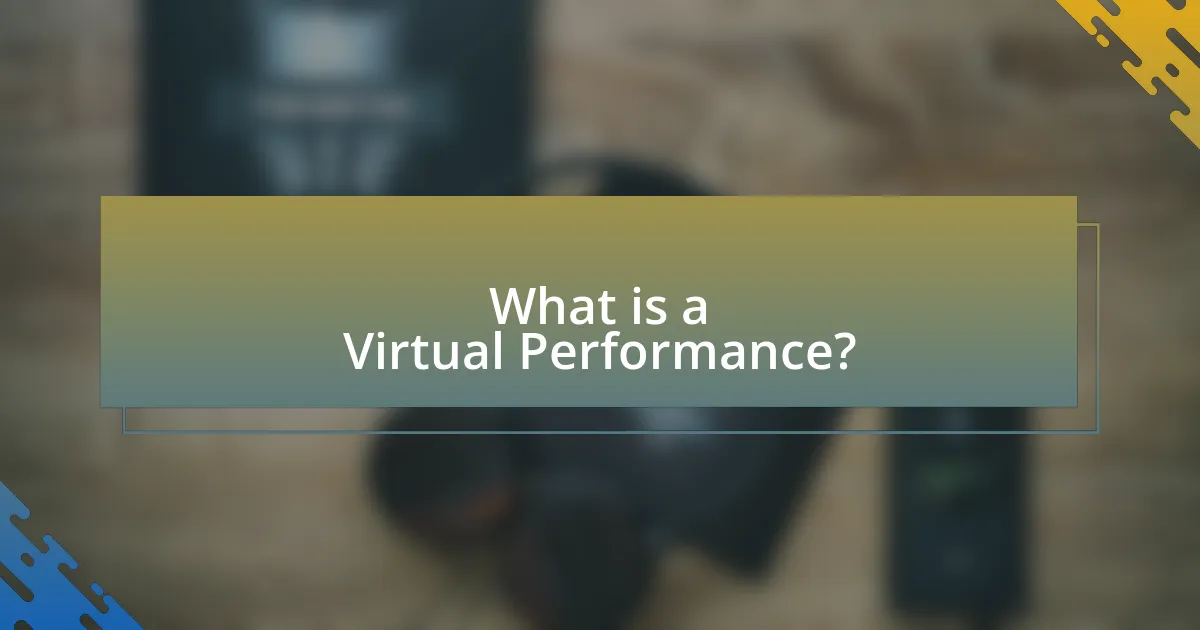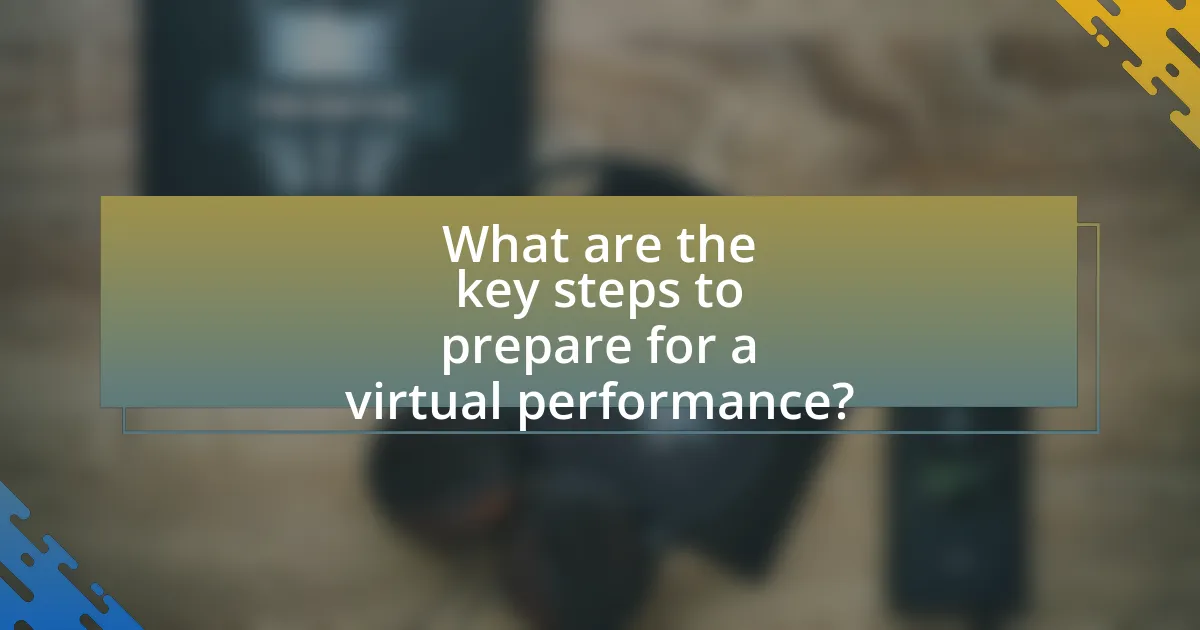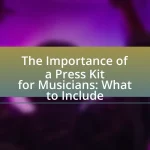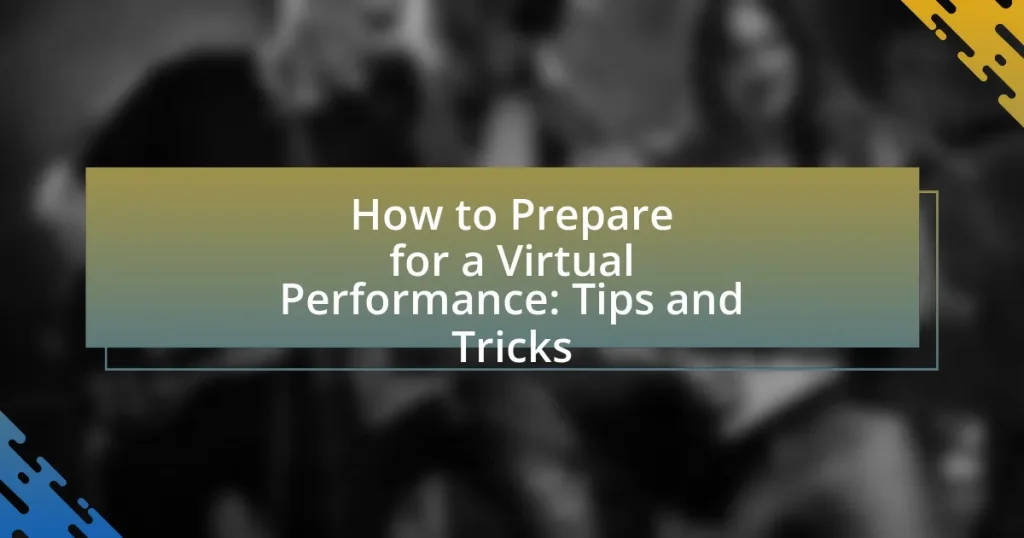The article focuses on the essential aspects of preparing for a virtual performance, highlighting the differences between virtual and traditional performances, and the technologies required for successful execution. It discusses the importance of preparation, including setting up the virtual environment, testing equipment, and rehearsal strategies to enhance audience engagement. Additionally, it addresses common challenges performers face in virtual settings and offers troubleshooting tips to mitigate technical difficulties. Key steps for effective audience interaction and maintaining energy during performances are also outlined, providing a comprehensive guide for artists adapting to the digital landscape.

What is a Virtual Performance?
A virtual performance is a live or pre-recorded artistic presentation delivered through digital platforms, allowing audiences to engage remotely. This format has gained popularity due to advancements in technology and the increasing accessibility of high-speed internet, enabling performers to reach global audiences without geographical constraints. Virtual performances can include various art forms such as music, theater, dance, and visual arts, often utilizing interactive elements to enhance viewer experience. The rise of virtual performances has been significantly influenced by events like the COVID-19 pandemic, which necessitated alternative methods for artists to connect with their audiences while adhering to social distancing measures.
How does a virtual performance differ from a traditional performance?
A virtual performance differs from a traditional performance primarily in its medium of delivery; virtual performances occur online, while traditional performances take place in physical venues. Virtual performances utilize digital platforms, allowing artists to reach a global audience without geographical limitations, whereas traditional performances are confined to specific locations and audiences present at the venue. Additionally, virtual performances often incorporate technology such as live streaming, interactive elements, and digital effects, which are not typically present in traditional performances that rely on live audience engagement and physical presence. This shift in medium has been accelerated by advancements in technology and the necessity for remote engagement, particularly highlighted during the COVID-19 pandemic, which saw a significant increase in virtual events as artists adapted to restrictions on live gatherings.
What technologies are essential for a virtual performance?
Essential technologies for a virtual performance include high-quality audio and video equipment, reliable streaming platforms, and stable internet connectivity. High-quality audio equipment, such as microphones and mixers, ensures clear sound, while professional cameras or webcams enhance visual quality. Streaming platforms like Zoom, YouTube Live, or Twitch facilitate audience engagement and interaction. A stable internet connection is crucial to prevent disruptions during the performance. These technologies collectively create an immersive experience for both performers and viewers, ensuring effective communication and engagement.
How do audience interactions change in a virtual setting?
Audience interactions in a virtual setting become more diverse and often less personal compared to in-person engagements. In virtual environments, interactions typically occur through chat functions, polls, and reaction emojis, which can lead to a more fragmented experience. Research indicates that 70% of virtual event attendees prefer using chat to engage with speakers, highlighting a shift from direct verbal communication to text-based interactions. Additionally, the anonymity provided by virtual platforms can encourage more participation from audience members who may feel hesitant to speak up in person. This change necessitates performers to adapt their engagement strategies, focusing on leveraging technology to foster connection and interaction.
Why is preparation crucial for a successful virtual performance?
Preparation is crucial for a successful virtual performance because it directly impacts the quality and engagement of the presentation. A well-prepared performer can effectively manage technical aspects, such as audio and video quality, ensuring a seamless experience for the audience. According to a study by the University of Southern California, 70% of virtual performances that included thorough preparation resulted in higher audience satisfaction ratings compared to those that did not prepare adequately. This highlights that preparation not only enhances the technical execution but also boosts the overall effectiveness of communication, leading to a more impactful performance.
What are the common challenges performers face in virtual settings?
Performers face several common challenges in virtual settings, including technical issues, lack of audience engagement, and difficulties in maintaining performance energy. Technical issues, such as poor internet connectivity or malfunctioning equipment, can disrupt the flow of a performance, leading to frustration and decreased quality. Additionally, the absence of a live audience can result in reduced interaction and feedback, making it harder for performers to gauge audience reactions and adjust their delivery accordingly. Furthermore, maintaining energy and presence in a virtual environment can be challenging, as performers may struggle to replicate the dynamic atmosphere of in-person events. These challenges highlight the need for performers to adapt their techniques and prepare thoroughly for virtual engagements.
How can effective preparation enhance audience engagement?
Effective preparation enhances audience engagement by ensuring that the content is relevant, well-structured, and tailored to the audience’s interests. When presenters invest time in understanding their audience’s preferences and expectations, they can create a more interactive and relatable experience. Research indicates that well-prepared presentations can increase audience retention by up to 70%, as effective organization and clarity help maintain attention and interest. Furthermore, preparation allows for the incorporation of engaging elements such as visuals, storytelling, and audience participation, which are proven to foster a deeper connection and enhance overall engagement during virtual performances.

What are the key steps to prepare for a virtual performance?
To prepare for a virtual performance, the key steps include setting up a suitable environment, testing technology, rehearsing thoroughly, and engaging with the audience. A suitable environment should be quiet, well-lit, and free from distractions to ensure a professional presentation. Testing technology involves checking internet connectivity, audio, and video equipment to avoid technical issues during the performance. Thorough rehearsals help performers become familiar with the content and flow, enhancing confidence and delivery. Engaging with the audience can be achieved through interactive elements, such as Q&A sessions or polls, which foster a connection and maintain interest. These steps are essential for delivering a successful virtual performance.
How should performers set up their virtual environment?
Performers should set up their virtual environment by ensuring proper lighting, sound quality, and a clutter-free background. Adequate lighting enhances visibility, making the performer more engaging; for instance, natural light or soft diffused lamps can create a professional appearance. High-quality audio equipment, such as a USB microphone, minimizes background noise and improves sound clarity, which is crucial for audience engagement. Additionally, a clean and organized background reduces distractions, allowing the audience to focus on the performance. These elements collectively contribute to a polished virtual presentation, as evidenced by industry standards that emphasize the importance of visual and auditory clarity in online performances.
What equipment is necessary for optimal sound and video quality?
To achieve optimal sound and video quality for a virtual performance, essential equipment includes a high-definition camera, a quality microphone, and proper lighting. A high-definition camera ensures clear video resolution, while a quality microphone captures sound accurately, reducing background noise and enhancing vocal clarity. Proper lighting, such as softbox lights or ring lights, illuminates the performer evenly, preventing shadows and improving visual quality. These components collectively enhance the overall production value, making the performance more engaging for the audience.
How can lighting affect the overall presentation?
Lighting significantly impacts the overall presentation by influencing visibility, mood, and audience engagement. Proper lighting enhances the clarity of visuals and ensures that the presenter is well-lit, which is crucial for maintaining viewer attention. Studies show that well-lit environments can increase viewer retention by up to 60%, as effective lighting helps to create a professional atmosphere and reduces distractions. Additionally, different lighting techniques can evoke specific emotions; for instance, warm lighting can create a welcoming ambiance, while cooler tones may convey professionalism. Thus, the strategic use of lighting is essential for optimizing the effectiveness of a virtual performance.
What rehearsal strategies should be employed?
Effective rehearsal strategies for a virtual performance include utilizing technology for remote collaboration, scheduling regular practice sessions, and incorporating feedback loops. Technology, such as video conferencing tools, allows performers to connect and rehearse together despite physical distances, enhancing coordination and timing. Regular practice sessions help maintain consistency and build confidence, while feedback loops, where performers review recordings of their rehearsals, enable them to identify areas for improvement. Research indicates that structured rehearsal practices significantly enhance performance quality, as seen in studies on performing arts education, which highlight the importance of consistent practice and constructive feedback in skill development.
How can performers simulate a live audience experience during rehearsals?
Performers can simulate a live audience experience during rehearsals by incorporating techniques such as using recorded audience sounds, inviting a small group of people to attend, or utilizing virtual reality technology. Recorded audience sounds, including laughter and applause, create an auditory backdrop that mimics a live audience, enhancing the performers’ engagement. Inviting a small group of friends or colleagues to observe the rehearsal provides real-time feedback and interaction, which can replicate the energy of a live audience. Additionally, virtual reality technology can immerse performers in a simulated audience environment, allowing them to practice their performance as if they were in front of a crowd. These methods have been shown to improve performers’ confidence and stage presence, as they adapt their delivery to the perceived audience response.
What role does feedback play in rehearsal effectiveness?
Feedback is crucial for rehearsal effectiveness as it provides performers with specific insights into their strengths and areas for improvement. This process allows individuals to adjust their techniques, enhance their performances, and align with the overall goals of the production. Research indicates that feedback can significantly increase learning outcomes; for instance, a study published in the Journal of Educational Psychology found that timely and constructive feedback improves skill acquisition and retention in performing arts settings. Thus, incorporating feedback into rehearsals leads to more polished and cohesive virtual performances.

What tips can enhance the overall virtual performance experience?
To enhance the overall virtual performance experience, ensure high-quality audio and video equipment is used. High-definition cameras and professional microphones significantly improve clarity, making the performance more engaging for the audience. Additionally, optimizing lighting conditions can enhance visual appeal; natural light or soft, diffused lighting creates a more inviting atmosphere. Engaging with the audience through interactive elements, such as live Q&A sessions or polls, fosters a sense of connection and participation. Furthermore, rehearsing in the virtual environment allows performers to familiarize themselves with the technology and troubleshoot potential issues, ensuring a smoother experience. Studies show that well-prepared virtual performances can increase audience retention and satisfaction, highlighting the importance of these tips.
How can performers engage their audience effectively?
Performers can engage their audience effectively by utilizing interactive elements such as live polls, Q&A sessions, and real-time feedback during virtual performances. These strategies foster a sense of participation and connection, which is crucial in a virtual environment where physical presence is absent. Research indicates that interactive features can increase audience retention and satisfaction, as seen in studies conducted by the University of Southern California, which found that audiences are more likely to remain engaged when they feel involved in the performance.
What interactive elements can be incorporated into a virtual performance?
Interactive elements that can be incorporated into a virtual performance include live polls, Q&A sessions, chat features, and audience participation activities. These elements enhance engagement by allowing viewers to influence the performance in real-time, fostering a sense of community and interaction. For instance, live polls can gauge audience preferences during the show, while Q&A sessions enable direct communication between performers and viewers, making the experience more immersive. Studies have shown that incorporating such interactive features can significantly increase viewer satisfaction and retention rates, as they create a more dynamic and participatory environment.
How can performers maintain energy and presence through a screen?
Performers can maintain energy and presence through a screen by utilizing strong vocal projection, engaging body language, and direct eye contact with the camera. Strong vocal projection ensures that the performer’s voice carries effectively, creating an engaging auditory experience for the audience. Engaging body language, including expressive gestures and movements, helps convey emotions and keeps the audience visually stimulated. Direct eye contact with the camera simulates connection, making viewers feel as though the performer is speaking directly to them, which enhances the overall presence. Research indicates that performers who actively engage with their audience through these methods can significantly improve viewer retention and emotional response, as evidenced by studies on virtual engagement in performance arts.
What are some common troubleshooting tips for virtual performances?
Common troubleshooting tips for virtual performances include checking internet connectivity, ensuring all software and hardware are updated, and testing audio and video equipment prior to the event. Internet connectivity issues can lead to disruptions, so a stable connection is crucial; using a wired connection instead of Wi-Fi can enhance stability. Keeping software updated prevents compatibility issues, while testing audio and video equipment ensures that sound and visuals are clear, which is essential for audience engagement. Additionally, having backup equipment and a contingency plan can mitigate unexpected technical difficulties during the performance.
How can performers prepare for technical difficulties?
Performers can prepare for technical difficulties by conducting thorough rehearsals with all equipment and technology involved. This preparation allows performers to identify potential issues, such as connectivity problems or equipment malfunctions, before the actual performance. According to a study by the University of Southern California, 70% of technical issues can be mitigated through proper rehearsal and testing of technology. Additionally, having a backup plan, such as alternative devices or platforms, ensures that performers can quickly adapt if problems arise during the performance.
What backup plans should be in place for unexpected issues?
Backup plans for unexpected issues during a virtual performance should include a reliable secondary internet connection, access to backup devices, and a contingency plan for technical difficulties. Establishing a secondary internet connection, such as a mobile hotspot, ensures that connectivity is maintained if the primary connection fails. Having backup devices, like an extra laptop or microphone, allows for quick replacements in case of hardware malfunctions. Additionally, creating a technical support contact list can facilitate rapid troubleshooting during the performance. These measures are essential as they minimize disruptions and maintain the quality of the virtual experience for the audience.
What best practices should performers follow for a successful virtual performance?
Performers should ensure high-quality audio and video for a successful virtual performance. This includes using a good microphone and camera, as poor sound and visuals can detract from the audience’s experience. Additionally, performers should rehearse in the actual performance space to familiarize themselves with the setup and troubleshoot any technical issues. Engaging with the audience through eye contact and interactive elements, such as Q&A sessions, enhances connection and keeps viewers invested. According to a study by the University of Southern California, audience engagement significantly impacts viewer satisfaction during virtual events.















